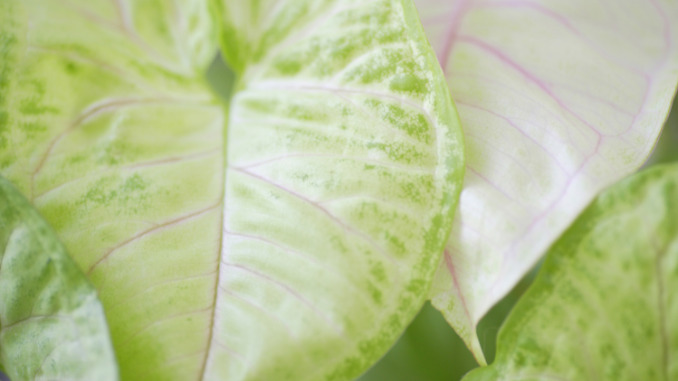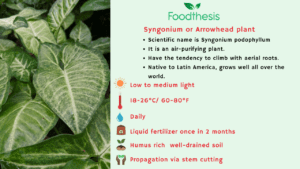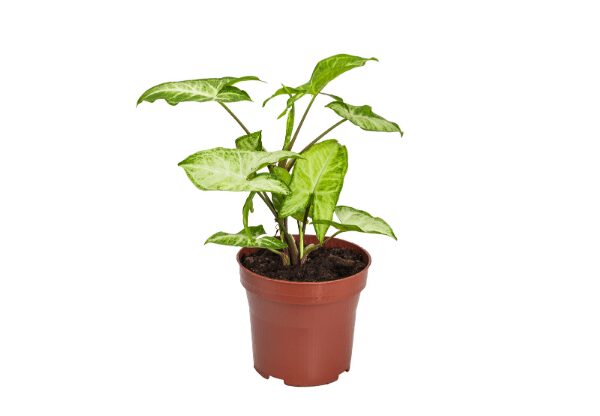Syngonium or Arrowhead plant
The Syngonium plant’s scientific name is Syngonium podophyllum and is a beautiful houseplant that also acts as an air purifier. The common name of this plant is arrowhead vine or arrowhead plant and goosefoot. This name is due to the heart-shaped leaves of the younger plants. Syngonium is a fast-growing tropical plant that has variegated green and white leaves when grown indoors and large green leaves when grown outdoors. This plant mainly grows in moist and shady conditions on fertile soil. Following are the Syngonium plant benefits.

Interesting facts:
- The leaf shape of this plant changes when the plant matures. The leaves when mature become well-lobed leaves from a singular pointy leaf.
- Also, have the tendency to climb with aerial roots.
Habitat
This plant is native to Latin America but is also found growing naturally in Texas, the West Indies, Hawaii, and Florida.
Syngonium plant is not only known for its ornamental values but also for its ability to purify air pollutants indoors, humidify, and helps to breathe fresh air (1).
Syngonium grows specifically in a moist shady place with a good amount of aeration.
Mode of propagation
Syngonium propagated mainly via the vegetative method of cutting of this process stem segments with few leaves are cut and then placed on moist soil for a few days till it develops roots.
Syngonium is mainly a climber or creeper in its nature, therefore, the stem of this plant develops roots whenever it touches the soil.
Uses
Syngonium is a beautiful foliage plant having arrow-shaped leaves. It can be used as a garden plant and also as an indoor house plant. The leaves of these plants are very beautiful and have a variegated pattern of cream white and green color. The plant gives a good lush green look to the indoor environment.
Syngonium plant benefits as an air purifier

Syngonium podophyllum also acts as an excellent air purifier. In a study done in the year 2013 (2), it was found that the plant Syngonium removes benzene and formaldehyde from indoor environments. Not only this, but the plant also helps in removing xylene and toluene also (1).
Benzene is one of the major VOCs released and pollutes the indoor air. Main sources include attached garages, automobile exhaust, heating and cooking systems of the houses, and many solvents (5).
Formaldehyde is also another indoor air pollutant emitted from smoking, candles, incense, cosmetics, wall paints, etc.
Medicinal uses of Syngonium plant
Synovium has several medicinal uses (3 & 4).
1. Treats stomachache
It’s crushed and boiled leaf decoction can be used to treat stomachache.
2. Releife frommtoothache
The milky-white sap of the stem can be used to alleviate tooth cavity pain.
3. Anti-inflammatory properties
The roots and bark of the plant contain antimicrobial and anti-inflammatory properties that make them effective in treating various conditions.
How to take care of the Syngonium plant

1. Light
Low to medium light is good for the proper growth of the Syngonium plant. The growth and development of this plant may be affected by direct sunlight.
2. Soil
Soil should be rich in humus along with good draining and aerating capacity. Therefore, soil should be moist for the better growth of the plant.
3. Water
Water daily or alternate days depending upon the temperature of the environment.
4. Fertilizers
Use liquid fertilizer for good growth.
5. Humidity
Regular misting is required during dry weather otherwise normal misting once in two or three days is enough for its proper and healthy growth.
Precautions
This plant is grown in many households for its excellent ability to purify the air and also beautify the interiors precautions should be taken care of if you got this plant in your house.
- Studies (3), suggested that the sap of the Syngonium plant is toxic as it causes skin irritation and is also not suitable to consume.
- The plant is found to be toxic in nature as the sap’s toxic elements lead to skin irritation and vomiting when consumed.
- Leaves have a major compound – calcium oxalate, which causes severe pain in the mouth.
- Thus, keep this plant away from children, and before using this plant please take advice of the experts or doctors.
Top Indoor air-purifying plants
- Snake Plant – Sanseveria air purification & health benefits
- Areca Palm: health benefits & air purification
- Pothos plant (Epipremnum aureum) – health benefits & air purification
- Anthurium andraeanum- health benefits & air purification
- Boston fern: health benefits & air purification
- Bamboo Palm: health benefits as an indoor plant

[…] Syngonium […]